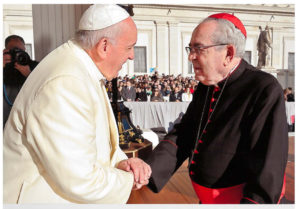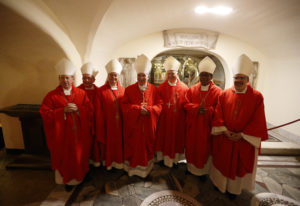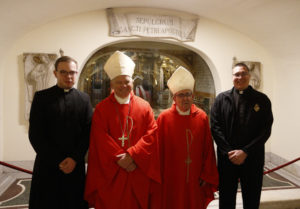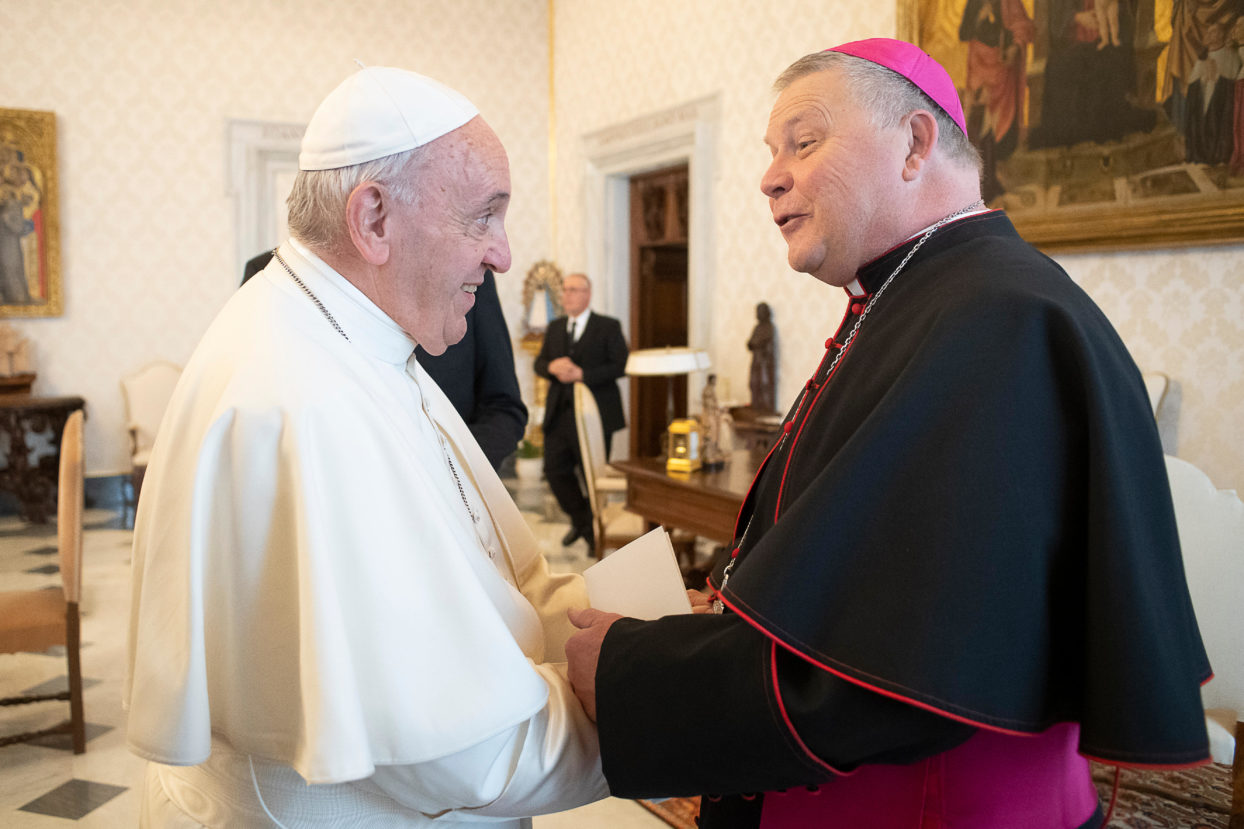Meetings between Pope Francis, Bishop Stika during ad limina visit yield a friendly exchange of information, ideas, opinions, and humor
By Jim Wogan
Bishop Richard F. Stika went to the Vatican in early December bearing good news about the Diocese of Knoxville, and despite a schedule that can best be described as frenetic, he returned to East Tennessee with a renewed sense of passion about the future of the Catholic Church and the man who currently leads it.
It was a business trip, officially known as ad limina apostolorum, a pilgrimage that, in particular, requires bishops from around the world to pray at the tombs of Sts. Peter and Paul once every five years. But the visit was much more. During his six days in Rome, Bishop Stika never strayed far from St. Peter’s Square, and his ad limina visit included meetings with the heads of six Vatican departments known as congregations and an inspiring meeting with the Holy Father, Pope Francis, which lasted nearly three hours.

Pope Francis poses in the papal library Dec. 3, 2019, with the bishops of U.S. Regions IV and V who were making their “ad limina” visits to the Vatican. (CNS photo/Vatican Media)
“Whenever I go to Rome I get a good dose of the universal Church, and I love St. Peter’s Square,” Bishop Stika said. “You see the tourists and the long lines waiting to get into the basilica. You see people with expressions of awe when they see the basilica and the Nativity crèche this time of year. Then, you go there late at night and it’s really quiet and you hear the church bells, and there are still tourists and you see it all lit up. For me, it’s just a reaffirmation of the universal Church.”
In fact, Bishop Stika’s first objective when arriving on Dec. 1 was to travel directly to St. Peter’s Basilica to pray at the tombs of St. John Paul II, St. John XXIII, St. Paul VI, and popes Pius XII, and John Paul I.
“These are the popes of my lifetime, and praying at their tombs is something I desire to do,” Bishop Stika said.
Prayer is a large component of an ad limina visit. In addition to his praying at the papal tombs, Bishop Stika celebrated Mass with other bishops at the four major basilicas in Rome: St. John Lateran, St. Peter’s, St. Mary Major, and St. Paul Outside the Walls.
Bishop Stika first traveled to the Vatican in 1988 when he was a priest in the Archdiocese of St. Louis. His first papal encounter was on that trip, when he met Pope St. John Paul II. In 2013, 30 days after the election of Pope Francis, Bishop Stika concelebrated Mass with the Holy Father. His most recent visit before the December ad limina was in 2015, when he met briefly with Pope Francis for a blessing of the dedication stone that is displayed in the Cathedral of the Most Sacred Heart of Jesus.
For this trip, Bishop Stika didn’t carry a 20-pound chunk of Tennessee marble as he did four years ago. Instead, he faced a heavy schedule of meetings with the leaders of the six Vatican congregations.
Three of the meetings — with the prefects of the congregations of Bishops, Clergy, and the Doctrine of the Faith, were mandated, as was the meeting with Pope Francis. Bishop Stika also elected to meet with the prefects of three other congregations, including the Congregation for the Causes of Saints to offer an update on the effort for sainthood for Father Patrick Ryan, a Catholic priest of East Tennessee who died of yellow fever in 1878 while ministering to sick patients in Chattanooga.

Pope Francis greets Cardinal Justin Rigali, archbishop emeritus of Philadelphia, during his general audience in St. Peter’s Square at the Vatican Dec. 4, 2019. (CNS photo)
Bishop Stika said the prefect, Cardinal Giovanni Angelo Becciu, offered useful information on how to “further advance the cause for Father Ryan,” who is currently venerated as a Servant of God. The meeting lasted 90 minutes.
During each of his meetings with the prefects, Bishop Stika shared the works of the Diocese of Knoxville detailed in a hefty 350-page quinquennial report compiled for the Vatican Curia by Deacon Sean Smith, who serves as Diocese of Knoxville chancellor.
The report elaborated on the growth in the number of registered parishioners and parishes since the last quinquennial report was presented in January 2012. It also described the significant growth taking place in diocesan ministries, including stewardship, communications, Hispanic, and youth and young adult outreach, and education.
“I was impressed with the prefects. They really do review the materials we send them, and they have a good idea and a genuine interest in what is taking place in the diocese,” Bishop Stika said. “It was a good visit, and Knoxville has a good reputation with the prefects. They were impressed with all of the reports, and so were some of my brother bishops who attended with me. The Congregation of Worship praised the diocese for the building of the new cathedral.”
Bishop Stika said that a meeting with the Vatican’s secretary of state, Cardinal Pietro Parolin, included discussion on the abuse crisis.
“I specifically asked about that,” Bishop Stika said. “The Vatican will soon come out with a report, and I offered the cardinal secretary my feelings that this issue is so important for the Church and that the people in the pews deserve to hear more.”
The bishop’s visit included a meeting with Matthew Donahue, a Diocese of Knoxville seminarian studying at the Pontifical North American College located near the Vatican. Bishop Stika spent at least two hours with seminarians at the Pontifical North American College answering questions and offering his perspective as a prelate of the Church.
Bishop Stika and 17 bishops from Tennessee, Kentucky, Louisiana, and Mississippi were scheduled to meet with Pope Francis in the papal library at the Vatican Palace on Dec. 5. That changed on the morning of Dec. 3. The bishops received a last-minute message that the meeting would begin that day at 10 a.m. Bishop Stika would now join 36 other bishops for the session.

U.S. bishops from Alabama, Kentucky, Louisiana, Mississippi, and Tennessee gather for a group photo in front of St. Peter after concelebrating Mass in the crypt of St. Peter’s Basilica at the Vatican Dec. 5, 2019. (CNS photo)
“When we first walked in, I was about the seventh or eighth bishop to enter. When I greeted him, I said, ‘Holy Father, the Diocese of Knoxville is praying for you.’ Then he pulled me into himself and he said, ‘for or against?’ I was kind of surprised that he said that, but we both laughed.
“Pope Francis speaks English; everybody thinks he doesn’t. He has some difficulty with English inflections, but he really does understand,” Bishop Stika said.
Bishop Stika said the meeting with the Holy Father and the bishops lasted nearly three hours and was “less formal” than the first ad limina meeting he attended with Pope Benedict XVI in 2012. That meeting included only six bishops.
“Pope Francis started by saying, ‘this meeting has no agenda. You tell me what you want to know and I will respond.’ He said you can praise, question, criticize, and then he said, ‘but only in this room, and I will do my best to share my thoughts.’”
Bishop Stika admitted there was a sense of “respectful tension” when the meeting began, but the Holy Father was very animated throughout the discussion. The shepherd of the Diocese of Knoxville felt that using his sense of humor in a deferential manner was the right way to make a point.
“You know in the United States, by your greeting to me, you might think that we don’t like you,” Bishop Stika said to the pope. “But I told him that it is a small minority. I also said that a small minority disagreed with Jesus and they eventually crucified him. The pope had a smile at that.”
“I smiled and said, ‘Holy Father, sometimes, just sometimes, you cause a little confusion for us by your statements, just a little bit,” the bishop continued, holding up two fingers close together to illustrate his point. “I said, ‘Can I get your cell phone number? Because if you give it to me, then I can call you for clarification,’ and then everybody laughed.”
The election of Cardinal Jorge Mario Bergoglio as Pope Francis has never been discussed in great detail. Members of the College of Cardinals, who elected the pope in 2013, are prohibited from discussing the matter. The College of Cardinals at that time included Cardinal Justin Rigali.
Bishop Stika felt comfortable asking the pontiff about his remembrance of that day.
“What was it like when you were sitting there and over, and over, and over again you heard the name Bergoglio, Bergoglio, Bergoglio during the election? What was it like for you as a human, thinking what was going to happen to you in your life? The pope paused and he said, ‘you know’ and he pointed at another cardinal in the room and said, ‘he is forbidden to speak about the election, but I’m not, because I am the pope’ and all of the bishops laughed again.”

Bishop Richard F. Stika of Knoxville, Cardinal Justin Rigali, archbishop emeritus of Philadelphia, and seminarians Wojciech Sobczuk and Matthew Donahue pose for a photo in front of the tomb of St. Peter in the crypt of St. Peter’s Basilica at the Vatican Dec. 5, 2019. (CNS photo)
Bishop Stika explained that Pope Francis spoke about many details of the election and the moment when it became evident that he, an archbishop from South America who had already submitted his request to Pope Emeritus Benedict XVI to retire, was about to become the leader of the world’s 1.3 billion Catholics and that his chosen name would be Francis.
“Since that moment, Pope Francis said, ‘I have been serene. Knowing now that I bear the cross that Peter bore, I have been serene every moment.’”
Bishop Stika called Dec. 3 one of the most exceptional days of his life. The meeting with the Holy Father was “real, real, real, human,” and that the pope “demonstrated a real love for the Church in America.” It was the fourth time he has met with Pope Francis.
“I connected with him like a human, as a brother bishop and a brother priest, and for seeing him as a nice guy who was chosen to do something extraordinary,” Bishop Stika said.
And while seeming to go out on a limb with his questions, Bishop Stika came away with what he considers a papal validation of sorts, that Francis said he “loved my joy, and he thanked me for my sense of humor.”
With a smile, Bishop Stika recalled his departing words to Pope Francis. “I told him I am not going to tell anybody, and then I smiled, and winked.”

